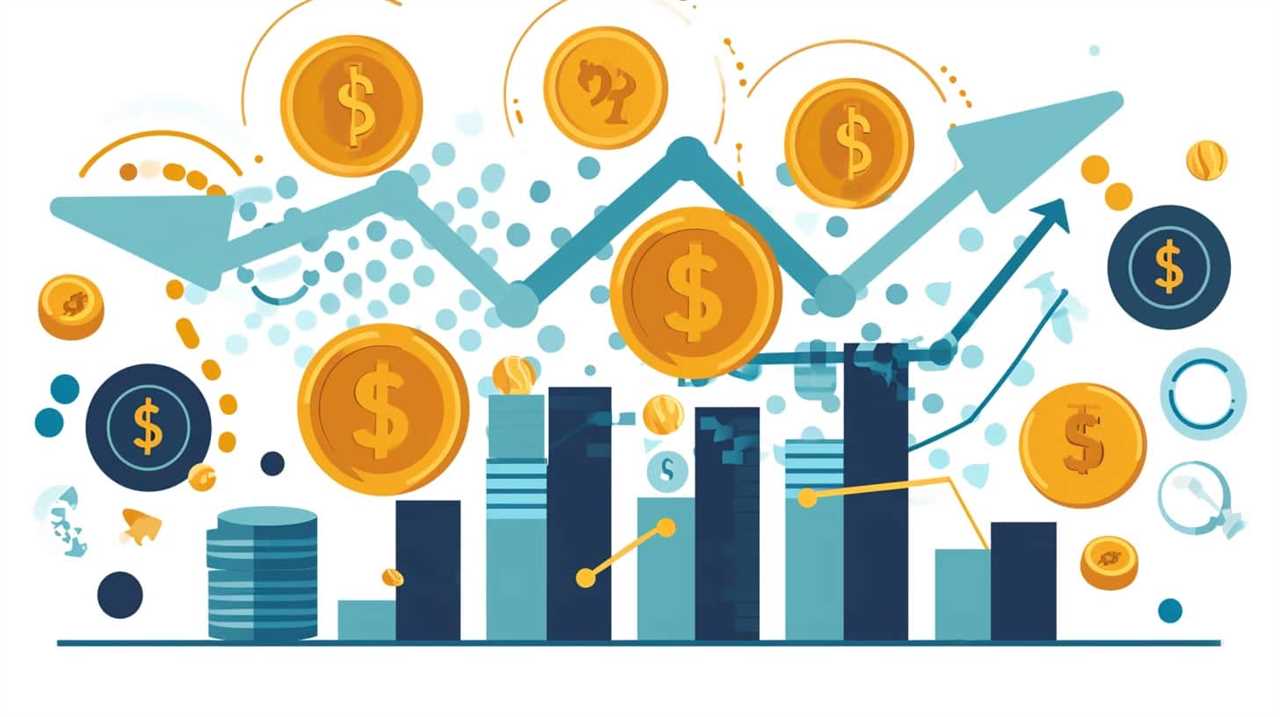As we strive for innovation, we frequently come across obstacles that prompt us to reconsider the state’s role in our economy.
As the saying goes, ‘necessity is the mother of invention.’ This holds true in the realm of economics, where John Maynard Keynes, a renowned economist, offered insightful perspectives on state intervention. His ideas challenge us to consider how government intervention can play a vital role in fostering economic stability and growth.
Through this exploration, we can gain valuable insights into the importance of fiscal policy, the government’s responsibility for full employment, and the management of market failures and financial crises.
Join us as we delve into Keynesian economics and unlock the potential of state intervention for a thriving economy.

Key Takeaways
- Government intervention is necessary to correct market failures.
- State intervention can help address income inequality.
- Keynesian economics supports government intervention for economic stability.
- Effective state intervention can promote economic growth.
The Role of Government in Economic Stability
We believe that the role of government in economic stability is crucial, as highlighted by the insights of John Maynard Keynes. In order to understand the importance of government intervention in maintaining economic stability, it’s necessary to examine two key aspects: the government’s role in income inequality and its intervention in market failures.
Income inequality has been a persistent issue in many economies. The government plays a vital role in addressing this through progressive taxation and redistribution policies. By implementing progressive taxes, the government can ensure that the burden of taxation falls on those who can afford it the most, thereby reducing income inequality. Additionally, through targeted welfare programs and social safety nets, the government can provide support to those who are economically disadvantaged, further reducing income inequality.
Moreover, government intervention is necessary to address market failures. Market failures occur when the invisible hand of the market fails to allocate resources efficiently. In such cases, the government can step in and provide public goods, regulate monopolies, and correct externalities. By doing so, the government can ensure a level playing field for all market participants, promote competition, and prevent the exploitation of consumers.
In conclusion, the government’s role in economic stability is crucial. By addressing income inequality and intervening in market failures, the government can foster an environment of fairness and stability in the economy.

Now, let’s delve into Keynes’ perspective on government intervention in markets.
Keynes on Government Intervention in Markets
Moving forward from our discussion on the role of government in economic stability, let’s now explore John Maynard Keynes’ perspective on the necessity of government intervention in markets.
Keynes believed that government intervention in markets was essential for maintaining stability and promoting efficiency. Here are four key insights from Keynes on government intervention in markets:
- Correcting Market Failures: Keynes argued that markets aren’t always efficient and can experience failures, such as unemployment and recessions. Government intervention is required to address these failures and restore stability. Through fiscal and monetary policies, governments can stimulate demand, create jobs, and stabilize the economy.
- Countercyclical Policies: Keynes advocated for countercyclical policies, which involve government intervention to counteract fluctuations in economic activity. During periods of recession, governments should increase spending and lower taxes to boost aggregate demand. Conversely, during periods of inflation, governments should reduce spending and raise taxes to cool down the economy.
- Supporting Aggregate Demand: According to Keynes, government intervention is necessary to ensure adequate levels of aggregate demand. By investing in infrastructure projects, providing unemployment benefits, and implementing progressive taxation, governments can support demand and maintain a stable economy.
- Stabilizing Financial Markets: Keynes emphasized the importance of regulating financial markets to prevent speculative bubbles and financial crises. Government intervention through regulations, oversight, and lender of last resort functions can enhance market efficiency and prevent systemic risks.
State Intervention as a Tool for Economic Growth
When considering state intervention as a tool for economic growth, it’s important to examine the effectiveness, pros, and cons of Keynesian economic theory.

On one hand, state intervention can stimulate economic growth through increased government spending and investment. This can lead to job creation, increased consumption, and overall economic expansion.
However, critics argue that excessive state intervention can lead to inefficiencies, distortions in market mechanisms, and a crowding out of private sector investment.
Therefore, a balanced approach that considers the specific context and objectives is necessary when utilizing state intervention for economic growth.
Keynesian Economic Theory’s Effectiveness
Keynesian economic theory demonstrates the effectiveness of state intervention as a tool for promoting economic growth. The role of government in managing aggregate demand through fiscal policy has been a key aspect of Keynesian economics. Here are four reasons why Keynesian economic theory is effective in promoting economic growth through state intervention:

- Countercyclical fiscal policy: By using expansionary fiscal measures during economic downturns, such as increasing government spending or cutting taxes, Keynesian theory aims to boost aggregate demand and stimulate economic activity.
- Demand-side management: Keynesian economics recognizes that inadequate aggregate demand can lead to unemployment and recession. By using fiscal policy to stimulate demand, the theory aims to prevent or mitigate these negative economic effects.
- Multiplier effect: Keynesian theory suggests that government spending can have a multiplier effect on the economy, meaning that every dollar spent by the government can generate a larger increase in overall economic output.
- Economic stability: Through state intervention, Keynesian economics aims to stabilize the economy by actively managing aggregate demand. By adjusting government spending and taxation levels, policymakers can influence economic activity and promote stability in the face of economic fluctuations.
Pros and Cons?
From our perspective, state intervention as a tool for economic growth has both advantages and disadvantages. On one hand, it can stimulate economic activity and address market failures. The government can invest in infrastructure, education, and research and development, which can lead to increased productivity and innovation. Additionally, state intervention can provide social safety nets and redistribute wealth, reducing inequality and promoting social cohesion. On the other hand, state intervention can be ineffective and limit individual freedom. Excessive government control may stifle entrepreneurship and innovation, hindering economic growth. Moreover, corruption and bureaucratic inefficiencies can undermine the effectiveness of state intervention. It is essential to strike a balance between government intervention and free markets, considering the pros and cons, effectiveness, and limitations of state intervention.
| Pros | Cons | Effectiveness | Limitations |
|---|---|---|---|
| Stimulates economic activity | Limits individual freedom | Can address market failures | Excessive government control |
| Invests in infrastructure, education, and research | Stifles entrepreneurship and innovation | Provides social safety nets | Corruption and bureaucratic inefficiencies |
| Reduces inequality | Hinders economic growth | Promotes social cohesion |
The Importance of Fiscal Policy in Keynesian Economics
Fiscal policy plays a pivotal role in Keynesian economics, shaping the state’s intervention in the economy. Here are four reasons why fiscal policy is of utmost importance:
- Economic Stabilization: Fiscal policy can be used to stabilize the economy during times of recession or inflation. By adjusting government spending and taxation levels, policymakers can influence aggregate demand and help steer the economy towards stability.
- Countercyclical Measures: Keynesian economics advocates for countercyclical measures, which involve increasing government spending during downturns and reducing it during boom periods. This helps to offset fluctuations in private sector spending and maintain overall economic stability.
- Boosting Aggregate Demand: Through fiscal policy, the government can directly stimulate aggregate demand by increasing public spending on infrastructure projects, education, healthcare, and other areas. This increased spending creates jobs, boosts consumer confidence, and drives economic growth.
- Income Redistribution: Fiscal policy can also be used to promote income redistribution and reduce inequality. By implementing progressive taxation and social welfare programs, the government can address disparities in income distribution and ensure a more equitable society.
Keynesian Theory: Government’s Responsibility for Full Employment
Keynesian theory asserts that the government plays a crucial role in ensuring full employment. By implementing policies that promote job creation, such as increased government spending and tax cuts, the government can stimulate economic activity and reduce unemployment rates.
Additionally, Keynesian economics emphasizes the need for government intervention during economic downturns to maintain economic stability and prevent recessions. The impact of Keynesian policies can be seen in historical examples such as the New Deal in the United States, which successfully addressed high unemployment rates during the Great Depression.

Government and Job Creation
We believe it’s crucial for the government to actively promote job creation in order to achieve full employment, as emphasized by renowned economist John Maynard Keynes.
In today’s rapidly changing economy, government intervention plays a vital role in driving economic development and job creation. Here are four reasons why government intervention is necessary for job creation:
- Stimulating demand: By implementing fiscal policies such as increased government spending and tax cuts, the government can boost consumer demand, leading to increased production and job opportunities.
- Infrastructure investment: Governments can invest in infrastructure projects such as transportation networks and renewable energy systems. These investments not only create jobs directly but also attract private sector investment and stimulate economic growth.
- Education and skill development: Governments can invest in education and skill development programs to equip the workforce with the necessary skills for emerging industries. This ensures that job seekers have the qualifications required for available job opportunities.
- Support for small businesses: Governments can provide financial assistance, tax incentives, and regulatory support to small businesses, which are often significant contributors to job creation. This support enables small businesses to thrive and expand, leading to increased employment opportunities.
Economic Stability Through Intervention
Ensuring economic stability through government intervention is essential for achieving full employment, according to the insights of renowned economist John Maynard Keynes. Keynesian theory emphasizes the role of government in maintaining economic stability and preventing recessions.
By actively intervening in the economy, the government can regulate aggregate demand and stabilize fluctuations in output and employment. Through expansionary fiscal policies, such as increased government spending and tax cuts, the government can stimulate economic activity and create employment opportunities.

Additionally, the government can employ monetary policies, such as lowering interest rates and implementing quantitative easing, to encourage investment and boost economic growth. By actively managing the economy, governments can play a crucial role in achieving and maintaining economic stability, which is vital for sustained full employment and overall prosperity.
Impact of Keynesian Policies
Building on the importance of government intervention in ensuring economic stability, our focus now shifts to the impact of Keynesian policies in fulfilling the government’s responsibility for achieving full employment.
Keynesian policies, based on the theories of renowned economist John Maynard Keynes, emphasize the role of government in managing aggregate demand to stabilize the economy and promote job creation. Here are four key impacts of Keynesian policies:
- Increased government spending: Keynesian economics advocates for increased government spending during times of economic downturn to stimulate demand and boost employment.
- Tax cuts: Keynesian policies also involve tax cuts, which aim to increase disposable income and encourage consumer spending.
- Monetary policy coordination: Keynesian theory emphasizes the need for coordination between fiscal and monetary policies to effectively manage aggregate demand and stabilize the economy.
- Countercyclical approach: Keynesian policies adopt a countercyclical approach, meaning that during periods of economic recession, the government should increase spending and reduce taxes to stimulate economic activity and job creation.
Government Intervention to Counteract Economic Downturns
Countering economic downturns requires implementing government intervention strategies to stabilize and stimulate the economy. Government intervention plays a crucial role in mitigating the negative impact of economic downturns by employing various policies and measures.

One such strategy is fiscal policy, where the government adjusts its spending and taxation to influence aggregate demand. By increasing government spending during a downturn, it injects money into the economy, stimulating consumption and investment. Additionally, the government can implement expansionary monetary policies, such as lowering interest rates or engaging in quantitative easing, to encourage borrowing and investment.
Evidence from past economic downturns supports the effectiveness of government intervention. During the Great Depression, for example, President Franklin D. Roosevelt’s New Deal programs helped alleviate the crisis by providing jobs, stimulating economic activity, and restoring confidence. Similarly, during the 2008 global financial crisis, governments worldwide implemented fiscal stimulus packages and monetary easing to stabilize their economies. These interventions helped prevent a deeper and more prolonged recession.
However, it’s crucial for governments to strike a balance between intervention and market forces. Excessive government intervention can distort market mechanisms and lead to unintended consequences. Therefore, policymakers must carefully assess the severity of the downturn and tailor intervention measures accordingly.
Keynes on the Need for Active Government Policies
In our analysis of John Maynard Keynes’ insights on state intervention, we find that active government policies are necessary for economic stability and growth. Keynes argued that government intervention is essential to counteract economic downturns and ensure a healthy functioning of the economy. Here are four key reasons why Keynes emphasized the need for active government policies:

- Demand Management: Keynes believed that government intervention is crucial in managing aggregate demand to prevent recessions and promote economic growth. By adjusting fiscal and monetary policies, governments can stimulate spending, investment, and consumption to maintain a stable level of demand.
- Countercyclical Policies: Keynes advocated for countercyclical policies, such as increasing government spending during economic downturns and reducing it during periods of prosperity. These policies help smooth out fluctuations in the business cycle and minimize the impact of recessions.
- Full Employment: Keynes argued that active government policies are necessary to achieve full employment. Through measures like job creation programs and infrastructure investment, governments can reduce unemployment rates and enhance economic productivity.
- Macroeconomic Stability: Government intervention plays a crucial role in maintaining macroeconomic stability. By implementing regulations, monitoring financial markets, and managing inflation, governments can ensure a stable and secure economic environment.
The Role of Government in Managing Aggregate Demand
Government plays a vital role in managing aggregate demand. By implementing various policies and interventions, the government can influence consumer spending, investment, and overall economic activity. One of the key tools used by governments for demand management is fiscal policy, which involves adjusting government spending and taxation to stimulate or restrain aggregate demand.
To provide a deeper understanding of government intervention in managing aggregate demand, let’s consider the following table:
| Government Intervention | Description | Examples |
|---|---|---|
| Fiscal Policy | The use of government spending and taxation to influence aggregate demand. | Increasing government spending during a recession to stimulate economic activity. |
| Monetary Policy | Control of the money supply and interest rates by the central bank to influence spending and investment. | Lowering interest rates to encourage borrowing and investment. |
| Public Investment | Government spending on infrastructure projects to boost demand and create jobs. | Building new roads, bridges, and schools to stimulate economic growth. |
| Income Redistribution | Policies aimed at reducing income inequality through taxation and welfare programs. | Implementing progressive tax rates and providing social assistance to low-income individuals. |
| Regulation | Government rules and regulations to ensure fair competition and protect consumers. | Enforcing antitrust laws to prevent monopolistic practices. |
These interventions play a crucial role in managing aggregate demand and ensuring economic stability and growth. However, it is also important to consider state intervention to prevent economic inequality, which we will explore in the next section.
State Intervention to Prevent Economic Inequality
When considering state intervention to prevent economic inequality, several key points come to mind.

First, effective wealth redistribution measures can help address the widening wealth gap and ensure a more equitable distribution of resources.
Second, balancing economic opportunities through policies such as progressive taxation and social welfare programs can help reduce disparities in income and access to education and healthcare.
Lastly, it’s important to consider the potential impact of state intervention on market efficiency, as excessive intervention may hinder economic growth and innovation.
Effective Wealth Redistribution
Addressing economic inequality through effective wealth redistribution is an essential aspect of state intervention, as advocated by John Maynard Keynes. In order to achieve this, various strategies can be implemented:

- Progressive Taxation: Implementing a progressive tax system where higher-income individuals are taxed at a higher rate can help redistribute wealth and reduce income inequality.
- Social Welfare Programs: Expanding social welfare programs such as healthcare, education, and housing can provide equal opportunities for all individuals, regardless of their socioeconomic background.
- Minimum Wage Policies: Implementing and enforcing minimum wage policies can ensure that workers receive fair compensation for their labor, reducing income inequality and improving living standards.
- Wealth Transfer: Implementing policies that encourage wealth transfer from the wealthy to the less fortunate, such as inheritance taxes or wealth taxes, can help reduce wealth concentration and promote a more equal society.
By implementing these wealth redistribution strategies, governments can effectively address income inequality and create a more equitable society.
Transitioning into the subsequent section about balancing economic opportunities, it’s important to strike a balance between wealth redistribution and fostering economic growth.
Balancing Economic Opportunities
To achieve a more equitable society, we must strive to balance economic opportunities through state intervention that prevents economic inequality.
Balancing economic opportunities is crucial for achieving equitable growth and ensuring that all individuals have a fair chance to succeed.

State intervention plays a pivotal role in this process by implementing policies that promote equal access to education, healthcare, and employment opportunities.
By investing in quality education for all, the state can equip individuals with the necessary skills and knowledge to compete in the job market.
Additionally, providing affordable healthcare and social safety nets can help prevent economic disparities caused by unforeseen circumstances such as illness or job loss.
Impact on Market Efficiency?
State intervention to prevent economic inequality has a significant impact on market efficiency. Here are four reasons why:

- Reducing income disparities: Government intervention can help redistribute wealth and bridge the gap between the rich and the poor. This leads to increased purchasing power for lower-income individuals, stimulating demand and promoting market efficiency.
- Enhancing social mobility: By providing equal opportunities for education and healthcare, government intervention can empower individuals to improve their skills and productivity. This enables them to participate more effectively in the labor market, leading to a more efficient allocation of resources.
- Mitigating market failures: Government intervention can address externalities, monopolies, and asymmetric information that hinder market efficiency. By regulating and monitoring these factors, the government ensures fair competition and promotes efficient resource allocation.
- Encouraging innovation and entrepreneurship: Government intervention can provide funding, tax incentives, and infrastructure support to foster innovation and entrepreneurship. This stimulates competition and encourages market participants to develop new products and services, driving market efficiency.
The Role of Government in Managing Inflation
We play a crucial role in managing inflation through government intervention. In response to inflation, governments implement various strategies to control rising prices and maintain price stability. One common strategy is monetary policy, which involves the use of interest rates and money supply to influence inflation levels. Central banks, such as the Federal Reserve in the United States, often employ this strategy to manage inflationary pressures. By raising interest rates, they aim to reduce borrowing and spending, which can help curb inflationary pressures. Conversely, lowering interest rates can stimulate borrowing and spending, thereby promoting economic growth but potentially leading to higher inflation.
Another strategy is fiscal policy, which involves government spending and taxation. Governments can adjust tax rates and spending levels to influence aggregate demand and inflation. For example, during periods of high inflation, governments may increase taxes or reduce spending to reduce demand and help control prices. Conversely, during economic downturns, governments may implement expansionary fiscal policies to stimulate demand and prevent deflation.
These inflation management strategies are essential tools that governments utilize to maintain stable economic conditions and promote long-term growth.
Transitioning into the next section, we’ll explore Keynes’ perspective on the government’s role in promoting investment.

Keynes on Government’s Role in Promoting Investment
When it comes to government’s role in promoting investment, there are several key points to consider.
First, government investment strategies can play a vital role in stimulating economic growth and development.
Second, Keynesian economics suggests that government intervention is necessary to address market failures and promote investment during times of economic downturn.
Lastly, the effectiveness of government intervention in promoting investment ultimately depends on various factors such as the design and implementation of policies, as well as the overall economic conditions.

Government Investment Strategies
To effectively promote investment, the government can implement strategic investment strategies, as advised by John Maynard Keynes. Here are four key strategies that the government can employ to stimulate investment and drive economic growth:
- Fiscal Policy: The government can use fiscal measures such as tax incentives and subsidies to encourage private investment. By reducing the cost of investment or providing financial support, the government can incentivize businesses to invest in new projects and expand their operations.
- Public Investment: The government can directly invest in infrastructure projects, research and development, and education to create a conducive environment for private investment. By investing in public goods, the government can attract private investors and stimulate economic activity.
- Monetary Policy: The government can influence interest rates and credit availability to encourage investment. Through its central bank, the government can lower interest rates, making borrowing cheaper and encouraging businesses to invest in new ventures.
- Regulatory Reforms: The government can introduce policies and regulations that promote a stable and predictable business environment. By reducing red tape, simplifying procedures, and ensuring fair competition, the government can create an attractive investment climate that encourages both domestic and foreign investors.
Keynesian Approach to Investment
How can the government actively promote investment according to John Maynard Keynes?
Keynesian investment strategies emphasize the government’s influence in stimulating economic growth through increased investment. According to Keynes, in order to encourage private investment, the government should adopt expansionary fiscal policies. This involves increasing government spending and reducing taxes to boost aggregate demand and create a favorable investment climate. By implementing infrastructure projects, providing subsidies, and offering tax incentives to businesses, the government can incentivize private sector investment.
Additionally, Keynes argued that the government should actively intervene during times of economic downturns by increasing public investment to create jobs and stimulate economic activity. By adopting these Keynesian policies, the government can play a crucial role in promoting investment and fostering economic growth.

Transitioning into the subsequent section about ‘economic growth through intervention’, it’s important to understand the broader implications of state intervention in the economy.
Economic Growth Through Intervention?
State intervention plays a pivotal role in promoting economic growth through actively supporting private sector investment, as outlined by John Maynard Keynes. Government intervention can stimulate economic development in several ways:
- Investment in infrastructure: Governments can invest in transportation, communication, and energy infrastructure, which enhances productivity and attracts private sector investment.
- Financial support: Governments can provide financial incentives such as tax breaks, grants, and low-interest loans to businesses, encouraging them to invest in research and development, innovation, and expansion.
- Market regulation: Governments can create a stable and predictable business environment through regulations that protect consumers, ensure fair competition, and provide legal frameworks for investment.
- Education and skills development: Governments can invest in education and skills development programs to create a highly skilled workforce, which attracts investment and drives economic growth.
State Intervention and Market Failures
In addressing market failures, we must consider the potential benefits of state intervention. While some may argue that government regulation and intervention can lead to market distortions, there are instances where it can effectively address market failures and promote innovation. Let us explore some of the key benefits of state intervention in the table below:
| Potential Benefits of State Intervention | Examples |
|---|---|
| Correcting externalities | Imposing carbon taxes to address climate change |
| Ensuring competition | Implementing antitrust laws to prevent monopolies |
| Providing public goods | Investing in infrastructure and education |
| Promoting social welfare | Implementing policies to reduce income inequality |
State intervention can play a crucial role in correcting market failures that arise from externalities, such as environmental pollution. By imposing carbon taxes, the government can incentivize businesses to reduce their carbon emissions and promote sustainable practices. Additionally, antitrust laws can prevent market distortions caused by monopolistic behavior, ensuring fair competition and encouraging innovation.

Moreover, state intervention can address market failures by providing public goods that the private sector may not adequately supply. Investments in infrastructure and education, for example, can create an environment conducive to innovation and economic growth.
Lastly, state intervention can promote social welfare through policies aimed at reducing income inequality. By implementing progressive taxation and social safety nets, governments can create a more inclusive society that fosters innovation and economic prosperity.
The Role of Government in Managing Financial Crises
As we delve into the role of government in managing financial crises, it’s important to recognize that state intervention can be a crucial tool in mitigating the negative impacts of economic downturns. The government’s role in financial regulation and its response to banking crises are paramount in maintaining stability and fostering innovation in the financial sector. Here are four key points to consider:
- Safeguarding the stability of the financial system: The government plays a crucial role in establishing and enforcing regulations that promote transparency, accountability, and risk management in the financial industry. By implementing measures such as capital requirements and stress testing, the government can reduce the likelihood of banking crises and prevent systemic risks.
- Providing liquidity support: During financial crises, liquidity shortage can exacerbate the situation, leading to a further deterioration of economic conditions. Governments can intervene by providing liquidity support to banks and financial institutions, ensuring their solvency and preventing a collapse in the credit market.
- Implementing fiscal stimulus measures: In times of financial crisis, the government can use fiscal policy tools to stimulate economic activity. By increasing government spending or cutting taxes, the government can boost aggregate demand and counteract the negative effects of a downturn.
- Restoring confidence and trust: Financial crises often erode public confidence in the financial system. The government can take measures to restore trust by enhancing transparency, strengthening consumer protection, and holding accountable those responsible for the crisis. Restoring confidence is crucial for the recovery of the financial sector and the overall economy.
As we transition to the subsequent section about ‘Keynes on the Limitations of Free Market Economics’, it’s important to understand that while government intervention can be effective in managing financial crises, it’s also essential to recognize the limitations of relying solely on free market economics.

Keynes on the Limitations of Free Market Economics
Moving on from the previous subtopic, we should now consider the limitations of free market economics as highlighted by John Maynard Keynes. While free market economics promotes efficiency and innovation, it isn’t without its flaws. One of the main limitations of free markets is the potential for market failures. These failures can occur due to externalities, such as pollution, where the costs aren’t borne by the parties involved in the transaction. In such cases, government intervention in markets becomes necessary to internalize these costs and ensure optimal outcomes.
Another limitation of free markets is the potential for inequality. Without government intervention, there’s a risk that wealth and resources become concentrated in the hands of a few, leading to social and economic disparities. Keynes argued that government intervention can help address this issue through progressive taxation and redistribution of wealth.
Moreover, free markets may not always provide adequate public goods, such as infrastructure and education, which are essential for economic growth and societal well-being. Government intervention is necessary to ensure the provision of these goods, as private markets may not have the incentives to do so.
Government Intervention to Stabilize Business Cycles
We should now delve into the use of government intervention to stabilize business cycles, as it continues the discussion from the previous subtopic on the limitations of free market economics.

- Countercyclical Fiscal Policy: Governments can use fiscal policy tools, such as changing tax rates or government spending, to counteract the ups and downs of business cycles. For example, during a recession, the government can increase spending or reduce taxes to stimulate economic activity and boost demand.
- Monetary Policy: Central banks play a crucial role in stabilizing business cycles by controlling the money supply and interest rates. By adjusting interest rates, central banks can influence borrowing costs, which in turn affect investment, consumption, and overall economic activity.
- Automatic Stabilizers: These are built-in mechanisms that automatically adjust government spending and taxation based on the state of the economy. For instance, during a recession, unemployment benefits increase, providing income support to those who’ve lost their jobs, and this helps stabilize consumer spending.
- Financial Regulation: Governments can intervene in financial markets to prevent excessive risk-taking and mitigate financial crises. Through regulations, such as capital requirements and stress tests, governments can ensure the stability of the financial system, reducing the likelihood of severe economic downturns.
Government intervention in business cycles aims to reduce volatility, promote stability, and foster sustainable economic growth. By implementing appropriate policies, governments can help prevent or limit the negative impacts of economic downturns, leading to more predictable and prosperous business environments.
Frequently Asked Questions
What Are Some Examples of Specific Government Interventions That Keynes Advocated for to Counteract Economic Downturns?
Keynesian theory highlights the importance of government intervention to counteract economic downturns. Some specific examples he advocated for include fiscal policies like increased government spending and tax cuts to stimulate demand and monetary policies like lowering interest rates to encourage investment.
How Does Keynesian Theory Address the Issue of Economic Inequality?
Keynesian theory addresses the issue of economic inequality by promoting a more equitable distribution of wealth through state intervention. The Keynesian approach to income redistribution aims to achieve social justice and reduce disparities in income and wealth.
What Are the Limitations of Free Market Economics According to Keynes?
The limitations of free market economics, as discussed by Keynes, highlight the importance of government intervention. By addressing market failures, promoting stability, and reducing inequality, state intervention can ensure a more equitable and efficient economy.

How Does Government Intervention Contribute to Managing Inflation?
Government intervention, through the role of monetary policy and government spending, plays a crucial role in managing inflation. By adjusting interest rates and controlling the money supply, the government can influence consumer spending and stabilize prices.
What Role Does Fiscal Policy Play in Keynesian Economics and Government Intervention?
Fiscal policy plays a crucial role in Keynesian economics and government intervention. It allows the government to regulate the economy through spending and taxation, stimulating demand during recessions and curbing inflation during economic booms.
How Does Friedman’s View on Money Supply Relate to Keynes’s Insights on State Intervention?
Friedman’s view on money supply emphasizes the importance of controlling the growth of money in the economy to prevent factors influencing inflation. Meanwhile, Keynes’s insights on state intervention suggest that government intervention can help to manage the economy and mitigate the negative effects of factors influencing inflation.
Conclusion
In conclusion, John Maynard Keynes’ insights on state intervention provide a compelling argument for the role of government in economic stability and growth.
His emphasis on the importance of fiscal policy, government responsibility for full employment, and addressing market failures highlights the limitations of free market economics.

By utilizing state intervention as a tool to manage financial crises and stabilize business cycles, Keynes offers a data-driven and objective approach to achieving economic success.
Lauren’s talent in writing is matched by her passion for storytelling. Her love for books and deep understanding of culture and entertainment add a distinct flavor to her work. As our media and press contact, Lauren skillfully bridges the gap between afterQuotes and the broader media landscape, bringing our message to a wider audience.










